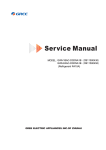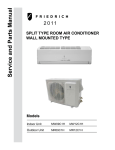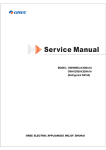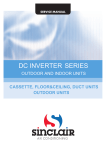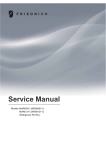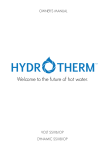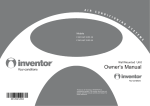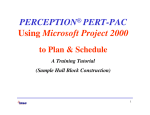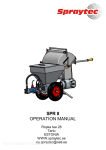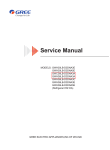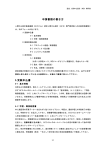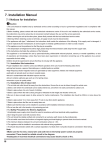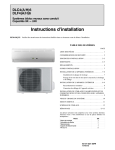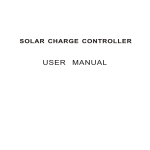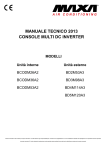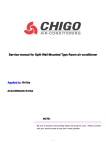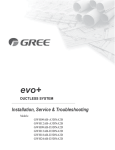Download Service Manual
Transcript
Service Manual MODEL:GWH09AB-A3DNA1B GWH12AB-A3DNA1B GWH12AB-D3DNA1B (Refrigerant R410A) GREE ELECTRIC APPLIANCES,INC.OF ZHUHAI Table of Contents Summary and features..................................................................................1 Part 1 Safety Precautions..........................................................................................2 Part 2 Specifications.....................................................................................................3 Part 3 Construction Views........................................................................................7 3.1 Indoor Unit .............................................................................................................7 3.2 Outdoor Unit ..........................................................................................................7 Part 4 Refrigerant System Diagram.....................................................................8 Part 5 Schematic Diagram........................................................................................9 5.1 Electrical Data........................................................................................................9 5.2 Electrical Wiring......................................................................................................9 5.3 Printed Circuit Board.............................................................................................12 Part 6 Function and Control...................................................................................15 6.1 Remote Control Operations..................................................................................15 6.2 Changing Batteries and Notices ..........................................................................17 6.3 Description of Each Control Operation.................................................................18 Part 7 Installation Manual ........................................................................................23 7.1 Notices for Installation...........................................................................................23 7.2 Installation Drawing..............................................................................................25 7.3 Install Indoor Unit.................................................................................................26 7.4 Install Outdoor Unit ..............................................................................................28 7.5 Check After Installation and Operation Test.........................................................29 Table of Contents Part 8 Exploded Views and Parts List..............................................................30 8.1 Indoor unit.............................................................................................................30 8.2 Outdoor unit..........................................................................................................34 Part 9 Troubleshooting...............................................................................................40 9.1 Malfunction Analysis.............................................................................................40 9.2 Flashing LED of Indoor/Outdoor Unit and Primary Judgement............................44 9.3 How to Check Simply the Main Part.....................................................................47 Part10 Removal Procedure.......................................................................................56 10.1 Removal Procedure of Indoor Unit.....................................................................56 10.2 Removal Procedure of Outdoor Unit...................................................................59 The pic. below is the actual panel and the vectorgraph in the manual is for reference only. Summary and features Summary and features Indoor Unit GWH09AB-A3DNA1B/I GWH12AB-A3DNA1B/I GWH12AB-D3DNA1B/I Outdoor Unit GWH09AB-A3DNA1B/O GWH12AB-A3DNA1B/O GWH12AB-D3DNA1B/O Remote control window YT1FF FAN MODE I FEEL CLOCK 1 TIMER ON X-FAN TEMP TIMER OFF TURBO SLEEP LIGHT 1.Safety Precautions Safety Precautions Installing, starting up, and servicing air--conditioning equipment can be hazardous due to system pressures, electrical components, and equipment location (roofs, elevated structures, etc.). Only trained, qualified installers and service mechanics should install, start--up, and service this equipment. Untrained personnel can perform basic maintenance functions such as cleaning coils. All other operations should be performed by trained service personnel. When working on the equipment, observe precautions in the literature and on tags, stickers, and labels attached to the equipment. Follow all safety codes. Wear safety glasses and work gloves. Keep quenching cloth and fire extinguisher nearby when brazing. Use care in handling, rigging, and setting bulky equipment. Read these instructions thoroughly and follow all warnings or cautions included in literature and attached to the unit. Consult local building codes and current editions of the National Electrical Code ( NEC ). Recognize safety information. This is the safety--alert symbol !! . When you see this symbol on the unit and in instructions or manuals, be alert to the potential for personal injury.Understand these signal words: DANGER, WARNING, and CAUTION. These words are used with the safety--alert symbol. DANGER identifies the most serious hazards which will result in severe personal injury or death. WARNING signifies hazards which could result in personal injury or death. CAUTION is used to identify unsafe practices which may result in minor personal injury or product and property damage. NOTE is used to highlight suggestions which will result in enhanced installation, reliability, or operation. ! The unit should be installed according to the instructions in order to minimize the risk of damage from earthquakes, hurricanes or strong winds. Contact of refrigerant and fire generates poisonous gas. Use specified refrigerant only. ! CAUTION UNIT DAMAGE HAZARD Failure to follow this caution may result in equipment damage or improper operation. Never use the system compressor as a vacuum pump. Refrigerant lines and indoor coil should be evacuated using the recommended deep vacuum method of 500 microns. The alternate triple evacuation method may be used if the procedure outlined below is followed. Always break a vacuum with dry nitrogen. Keep your fingers and clothing away from any moving parts. Clear the site after installation. Make sure no foreign objects are left in the unit. Always ensure effective grounding for the unit. WARNING Caution ELECTRICAL SHOCK HAZARD Failure to follow this warning could result in personal injury or death. Never install on the place where a combustible gas might leak , or it may lead to fire or explosion. Before installing, modifying, or servicing system, main electrical disconnect switch must be in the OFF position. There may be more than 1 disconnect switch. Lock out and tag switch with a suitable warning label. When the unit is installed at telecommunication centers or hospitals, take a proper provision against noise. Highly dangerous electrical voltages are used in this When installing at a watery place, provide an electric leak ground fault breaker. system. Carefully refer to the wiring diagram and these instructions when wiring. Improper connections or inad- Do not wash the unit with water. Be very careful about unit transportation.The unit should not equate grounding can cause accidental injury or death. Ground the unit according to local electrical codes. be carried by only one person if it is more than 45lb. Connect all wiring tightly. Loose wiring may cause overheating at connection points and a possible fire hazard. Do not touch the heat exchanger fins w i th bare hands. Make sure the ceiling/wall is strong enough to hold the unit’s weight. The outdoor unit should be installed in a Do not touch the compressor or refrigerant piping whithout wearing glove. location where air and noise emitted by the unit will not disturb the neighbors. Do not operate the air conditioner without air filter. Properly insulate any refrigerant or condensate linerunning inside a room to prevent "sweating" that can cause dripping water and damage to walls and floors. Should any emergency occur, stop the unit and disconnect the power immediately. The outdoor unit must be installed on stable, level surface, where there is no accumulation of snow, leaves or rubbish. 2 Specifications 2.Specifications Parameter Value Unit Model Product Code Power Supply Rated Voltage Rated Frequency V̚ Hz Phases Power Supply Model GWH09AB-A3DNA1B GWH12AB-A3DNA1B CB11500550 CB11500570 115 115 60 60 1 1 Outdoor Outdoor Cooling Capacity (Min̚Max) Btu/h 9000(4000̚11950) 12000(4500̚13000) Heating Capacity (Min̚Max) Btu/h 9500(3412̚12500) 11700(3200̚14000) Cooling Power Input (Min̚Max) W 630(166̚1180) Heating Power Input (Min̚Max) W 680(200̚1230) Cooling Power Current Heating Power Current A A 8 8.5 13 14.5 Rated Input W 1100 1300 Rated Current 960(160̚1180) 1140(400̚1250) A 10 12 Air Flow Volume CFM 300 Moisture Removal gal./hr 0.32 300 0.37 EER BTU/W 14.3 12.5 COP W/W 4.04 3.34 SEER W/W 23 22 HSPF W/W Application Area sq.ft. 9.8 Model of indoor unit Fan Type Diameter Length(DXL) inch 172-258 GWH09AB-A3DNA1B/I GWH12AB-A3DNA1B/I Cross-flow Cross-flow ĭ(3-3/8)X(26-3/10) ĭ(3-3/8)X(26-3/10) Fan Motor Cooling Speed (SH/H/M/L/SL) r/min 1400/1150/1050/900/- 1500/1150/1050/900/- Fan Motor Heating Speed (SH/H/M/L/SL) r/min 1450/1250/1150/1050/400 1450/1250/1150/1050/400 W 10 10 Output of Fan Motor Fan Motor RLA A / / Fan Motor Capacitor ȝF / / Input of Heater W Evaporator Form Indoor Unit 8.9 129-194 / / Aluminum Fin-copper Tube Aluminum Fin-copper Tube ĭ11/40 Pipe Diameter inch Row-fin Gap inch 2-1/17 Coil Length (LXDXW) inch (25-7/8)X1X(11-2/9) Swing Motor Model MP28VB ĭ11/40 2-1/17 (25-7/8)X1X(11-2/9) MP28VB Output of Swing Motor W 2 2 Fuse A 3.15 3.15 Sound Pressure Level (SH/H/M/L/SL) dB (A) 42/38/30/28/- 42/38/30/28/- Sound Power Level (SH/H/M/L/SL) dB (A) 52/48/40/38/- 52/48/40/38/- inch 34.3X11.1X7 34.3X11.1X7 Dimension of Carton Box (W/H/D) inch 36.8X14.7X10.2 36.8X14.7X10.2 Dimension of Package (W/H/D) inch 36.8X14.7X10.2 36.8X14.7X10.2 Net Weight lb. lb. Dimension (WXHXD) Gross Weight 26 33 3 26 33 Specifications Model of Outdoor Unit Compressor Manufacturer/Trademark GWH09AB-A3DNA1B/O GWH12AB-A3DNA1B/O CHINA RESOURCES(SHENYANG) SANYO COMPRESSOR CO. LTD./SANYO CHINA RESOURCES(SHENYANG) SANYO COMPRESSOR CO. LTD./SANYO C-6RZ110H1A FV50S Rotary C-6RZ110H1A FV50S Rotary 33.00 4.59 800 Int11l-3979 Electron expansion valve 61̚86 41̚115 33 4.59 800 Int11l-3979 Electron expansion valve Compressor Model Compressor Oil Compressor Type L.R.A. Compressor RLA Compressor Power Input Overload Protector Throttling Method Operation temp Ambient temp (cooling) Ambient temp (heating) Condenser Form Pipe Diameter Rows-fin Gap Coil Length (LXDXW) Fan Motor Speed Outdoor Output of Fan Motor Unit Fan Motor RLA Fan Motor Capacitor Air Flow Volume of Outdoor Unit Fan Type Fan Diameter Defrosting Method Climate Type A A W ºF ºF ºF 5̚86 Aluminum Fin-copper Tube inch ĭ3/8 2-1/18 inch inch rpm W (29-2/5)X(1-3/4)X20 830 30 61̚86 41̚115 5̚86 Aluminum Fin-copper Tube ĭ3/8 2-1/18 (29-2/5)X(1-3/4)X20 830 30 A ȝF / / / / CFM 1059 Axial-flow ĭ(15-3/4) Automatic Defrosting T1 1177 Axial-flow ĭ(15-3/4) Automatic Defrosting T1 I IP24 I IP24 inch Isolation Moisture Protection Permissible Excessive Operating Pressure for the Discharge Side Permissible Excessive Operating Pressure for the Suction Side MPa 3.8 3.8 MPa 1.2 1.2 Sound Pressure Level (H/M/L) Sound Power Level (H/M/L) Dimension (WXHXD) Dimension of Carton Box (W/H/D) dB (A) dB (A) inch inch 52/-/62/-/33.3X21.3X12.6 34.5X22.8X14.2 55/-/65/-/33.3X23.2X12.6 inch 34.5X22.8X14.2 lb. lb. 88 96 Dimension of Package (W/H/D) Net Weight Gross Weight Refrigerant Refrigerant Charge Precharge line length Gas Additional Charge Connecti Outer Diameter Liquid Pipe on Pipe Outer Diameter Gas Pipe Max Distance Height Max Distance Length R410A oz. ft. lb./ft. inch 47.6 16 0.14 ĭ1/4 inch ft. ft. ĭ3/8 33 66 The above data is subject to change without notice. Please refer to the nameplate of the unit. 4 34.5X24.8X14.2 34.5X24.8X14.2 90 99 R410A 47.6 16 0.14 ĭ1/4 ĭ1/2 33 66 Specifications Parameter Unit GWH12AB-D3DNA1B Model CB11500380 Product Code Power Supply Value Rated Voltage Rated Frequency V̚ Hz 208/230 60 Phases 1 Power Supply Model Outdoor Cooling Capacity (Min̚Max) Btu/h 12000(4500̚13000) Heating Capacity (Min̚Max) Btu/h 13000(3200̚14000) Cooling Power Input (Min̚Max) W 960(160̚1180) Heating Power Input (Min̚Max) W 1140(400̚1250) Cooling Power Current A 5 Heating Power Current A 5.5 Rated Input W 1200 Rated Current A 6 Air Flow Volume CFM 330 Moisture Removal gal./hr. 0.37 EER BTU/W 12.5 COP W/W 3.34 SEER W/W 22 HSPF W/W 10.5 sq.ft. 172-258 GWH12AB-D3DNA1B/I Application Area Model of indoor unit Fan Type Cross-flow Diameter Length(DXL) inch ĭ(3-3/8)X(26-3/10) Fan Motor Cooling Speed (SH/H/M/L/SL) r/min 1500/1150/1050/900/- Fan Motor Heating Speed (SH/H/M/L/SL) r/min 1450/1250/1150/1050/400 Output of Fan Motor W 10 Fan Motor RLA A / Fan Motor Capacitor ȝF / Input of Heater W / Evaporator Form Indoor Unit Aluminum Fin-copper Tube Pipe Diameter inch ĭ11/40 Row-fin Gap inch 2-1/17 Coil Length (LXDXW) inch Swing Motor Model Output of Swing Motor Fuse (25-7/8)X1X(11-2/9) MP28VB W 2 A 3.15 Sound Pressure Level (SH/H/M/L/SL) dB (A) 47/38/30/28/- Sound Power Level (SH/H/M/L/SL) dB (A) 57/48/40/38/- Dimension (WXHXD) inch 34.3X11.1X7 Dimension of Carton Box (W/H/D) inch 36.8X14.7X10.2 Dimension of Package (W/H/D) inch 36.8X14.7X10.2 Net Weight lb. 26 Gross Weight lb. 33 5 Specifications Model of Outdoor Unit GWH12AB-D3DNA1B/O CHINA RESOURCES(SHENYANG) SANYO COMPRESSOR CO. LTD./SANYO Compressor Manufacturer/Trademark Compressor Model Compressor Oil C-6RZ110H1A FV50S Compressor Type L.R.A. A Rotary 33.00 Compressor RLA Compressor Power Input A W 4.59 800 Overload Protector Throttling Method Int11l-3979 Electron expansion valve Operation temp Ambient temp (cooling) ºF ºF Ambient temp (heating) Condenser Form ºF 5̚86 Aluminum Fin-copper Tube inch inch ĭ3/8 2-1/18 inch rpm W A ȝF (29-2/5)X(1-3/4)X22 830 30 / / CFM 1177 Axial-flow ĭ(15-3/4) Automatic Defrosting T1 I IP24 Pipe Diameter Rows-fin Gap Coil Length (LXDXW) Fan Motor Speed Output of Fan Motor Outdoor Fan Motor RLA Unit Fan Motor Capacitor Air Flow Volume of Outdoor Unit Fan Type Fan Diameter Defrosting Method Climate Type Isolation Moisture Protection Permissible Excessive Operating Pressure for the Discharge Side inch Permissible Excessive Operating Pressure for the Suction Side Sound Pressure Level (H/M/L) Sound Power Level (H/M/L) Dimension (WXHXD) 61̚86 41̚115 PSI 551 PSI 174 dB (A) dB (A) inch 55/-/65/-/33.3X23.2X12.6 Dimension of Carton Box (W/H/D) inch 34.5X24.8X14.2 Dimension of Package (W/H/D) Net Weight Gross Weight inch lb. lb. 34.5X24.8X14.2 90 99 Refrigerant Refrigerant Charge R410A oz. 45.8 Precharge line length Gas Additional Charge ft. lb./ft. 16 0.14 inch inch ĭ1/4 ĭ1/2 ft. ft. 33 66 Connecti Outer Diameter Liquid Pipe on Pipe Outer Diameter Gas Pipe Max Distance Height Max Distance Length The above data is subject to change without notice. Please refer to the nameplate of the unit. 6 Constrction views 3. Construction Views 11-1/7 3.1 Indoor Unit (THE SAME DIMS FOR 9k12k) 34-1/3 7 12K Unit: 4 23-4/5 6-8/15 H 3.2 Outdoor Unit W D 11-1/4 Unit:inch 21-1/4 7 Model W H D 09K 33-3/8 21-1/4 12-3/5 12K 33-3/8 23-2/9 12-3/5 Refrigerant System Diagram 4. Refrigerant System Diagram Heat exchanger ( INDOOR ) Compressor Muffler 4-Way valve Sub-accumulator Strainer Expansion valve Heat exchanger ( OUTDOOR ) Strainer Cooling Heating Refrigerant Pipe Diameter Liquid Gas 09K 1/4ą 3/8ą 12K 1/4ą 1/2ą 8 Schematic Diagram 5. Schematic Diagram 5.1 Electrical Date Indoor Unit Symbol Color symbol Symbol Color symbol WH WHITE BN YE YELLOW BU BLUE RD RED BK BLACK YEGN BROWN YELLOW GREEN Ground Outdoor Unit Symbol Parts name Symbol L1 L2 1OLQH)URQWOLQH WH WHITE YELLOW RED 4YV ZD\YDOY YE EKV electric expansion valv RD Color symbol L reactor BN SAT OVERLOAD BN BROWN COMP COMPRESSOR BU BLUE Ground BK BLACK YEGN YELLOW GREEN 5.2 Electrical wiring Indoor Unit (1) Models GWH09AB-A3DNA1B/I ,GWH12AB-A3DNA1B/I ROOM TUBE TEM.SENSOR TEM.SENSOR 0 RT2 ROOM N1 DISP3 DISP4 TUBE W4 BU L1 COM-INNER JUMP SWING-UD L AP2 W5 BK W3 BN L1 XT1 N(1) 2 3 W2 YEGN W1YEGN CN1 HEALTH-LHEALTH-N RD M STEP MOTOR M FANMOTOR BU COOL PLASMA GENERATOR YEGN G 9 EVAPORATOR ELECTRIC BOX G G OUTDOOR UNIT 0 RT1 AP1 DISPLAY Schematic Diagram (2) Model GWH12AB-D3DNA1B/I ROOM TUBE TEM.SENSOR TEM.SENSOR 0 RT2 ROOM TUBE L1 L1 E SWING-UD 2 3 W3BN L AP2 N(1) W5BK COM-INNER JUMP XT1 W4BU N1 DISP3 DISP4 W2YEGN L1 W1 YEGN W6YEGN CN1 OUTDOOR UNIT 0 RT1 AP1 DISPLAY HEALTH-L HEALTH-N RD M ELECTRIC BOX G G BU COOL PLASMA GENERATOR M STEP MOTOR EVAPORATOR YEGN G FAN MOTOR Outdoor Unit (1) Models GWH09AB-A3DNA1B/O,GWH12AB-A3DNA1B/O COMP CT1,2 W10 RD W3 YEGN R COMP E TUBE OUTROOM EXHUAST TEM.SENSOR TEM.SENSOR TEM.SENSOR RT3 RT4 RT5 0 0 0 L2 L2 G XT2 G W V OUTROOM EXHAUST W15 BU N(1) W4 BK 2 3 AP1 COMU W14 BN FILTER L1 W1 BN L U N I T OVERHEAT OUTTUBE E G L2 W5 BU W6 YE W7 BK U I N D O O R C W8 YEGN S L1 W2 BU N 1 3 2 4 L4 W17 RD L4 W16 WH AC-L1 AC-N1 CN1 OFAN EKV M E W13 YEGN POWER N L AC-N3 AC-N4 AC-L3 AC-L2 AC-N5 AC-L2 AC-L4 4V AC-N2 W18 YEGN W20 BU W23 OG W21 BN G G W19 BU W24 RD C4 C3 1 2 2 1 W22 WH 10 4YV FAN MOTOR G Schematic Diagram (2) Models GWH09AB-A3DNA1B/O,GWH12AB-A3DNA1B/O COMP CT1,2 W3 YEGN W10 RD I N D O O R RT4 RT5 0 0 0 L2 L2 W5 BU W6 YE OUTTUBE OUTROOM C W8 YEGN S U OVERHEAT XT2 L2 W7 BK V G W EXHAUST W15 BU N(1) L1 W4 BK 2 3 L1 W1 BN L1 W2 BU L2 G AP1 COMU W14 BN L1 U N I T RT3 E G G R COMP E TUBE EXHUAST OUTROOM TEM.SENSOR TEM.SENSOR TEM.SENSOR AC-L1 N1 CN1 OFAN 4V W13 YEGN AC-L2 AC-L3 N2 N3 POWER N W12 WH W11 OG M L EKV 4YV G L W 9 BU FAN MOTOR G These circuit diagrams are subject to change without notice, please refer to the one supplied with the unit. 11 Schematic Diagram 5.3 Printed Circuit Board Interface of indoor fan Transformer with Auto button high frequency Vertical swing Interface for live wire of health function Interface for display Interface for communication Protective tube Jumper cap Interface for null wire of health function TOP VIEW Indoor tambien temp sensor Main chip Indoor pipe temp sensor BOTTOM VIEW 12 Schematic Diagram (1) Models GWH09AB-A3DNA1B/O , GWH12AB-A3DNA1B/O TOP VIEW Jumper null wire Positive pole of big capacitor Jumper null wire (brown wire) Negative pole of big capacitor (blue wire) Terminal for fan Terminal for 4-way valve electronic expansion valve Terminal for live wire Terminal for null wire of 4-way valve Jumper live wire Terminal for ground wire Jumper live wire, joint terminal for positive pole and negative pole of two capacitors( orange wire) Protective tube for switch power Transformer with high frequency Voltage regulator 7805 IPM module Overload temp sensor Three-phase terminal of compressor Phase U-blue wire Phase Y-yellow wire Phase W-red wire BOTTOM VIEW 13 Outdoor ambient temp sensor Compressor discharge temp sensor Terminal for null wire Outdoor pipe temp sensor Terminal for communication wire connecting to black communication wire of IDU. Schematic Diagram (2) Model GWH12AB-D3DNA1B/O TOP VIEW Electrolysis condenser Jumper terminal for null wire, connecting to N3 electronic expansion valve Terminal for DC fan Terminal for live wire connecting to reactor and 4-way valve Terminal for 4-way valve Main relay Terminal for ground wire Terminal for live wire, connecting to reactor Jumper terminal for null wire, connecting to N2 Protective tube Chip for switch power Voltage regulator7805 IPM module Transformer with high frequency Compressor discharge temp sensor Terminal for overload protector of compressor BOTTOM VIEW 14 Terminal for communication wire Outdoor ambient Outdoor pipe temp sensor temp sensor Terminal for live wire Terminal for null wire Function and Control 6. Function and Control 6.1 Remote Control Operations 1 ON/OFF Button 2 Setpoint Temperature DOWN Button 3 Setpoint Temperature UP Button 4 FAN Speed Button 5 MODE Button 6 1 2 4 6 7 HEALTH function Button 8 AIR function Button 3 5 7 8 9 10 11 12 13 14 15 16 17 I FEEL Button 9 10 Clock Button Timer ON Button 11 12 X-FAN Button 13 Temperature Displaye Button 14 TIMER OFF Button 15 TURBO Button 16 Sleep Mode Button 17 Light Mode Button (X-FAN is the alternative expression of BLOW for the purpose of understanding.) 1 Press this button, the unit will be turned on, press it once more, the unit will be turned off. 2 . button, sets temperature,when unit is on . Continuously press and hold this To lower temperature set point. Press this button for more than 2 seconds,the corresponding contents will be changed rapidly,but in AUTO mode, set temperature is not adjustable. 3 +: To increase temperature set point. Press this button, the temperature can be set up, continuously press this button and hold for two seconds, the relative contents can quickly change, but in AUTO mode, set temperature is not adjustable. 4 FAN : Press this button, Auto, Low, Middle, High speed can be circularly selected. After powered on, Auto fan speed is default. Under Dehumidify mode, Low fan speed only can be set up. 15 Function and Control Auto Low speed Medium speed High speed 5 MODE : Press this button, Auto, Cool,Dry, Fan, Heat mode can be selected circularly. Auto mode is default while power on. Under Auto mode, the temperature will not be displayed; In this mode, the unit will automatically select the suitable operation mode in accordance with the room temperature to make the room more comfortable for you. AUTO COOL DRY FAN HEAT Note:Only for models with heating function. 6 I FEEL : Press this button, I FEEL On and I FEEL Off can be selected.In the I FEEL function. The unit will adjust temperature automatically according to the sensed temperature. 7 (The function is not for the models mentioned in the manual.) Press this button to set HEALTH function ON or OFF. After the unit is turned on, it defaults to HEALTH function ON. 8 (The function is not for the models mentioned in the manual.) Press this button to select AIR function ON or OFF. 9 CLOCK : Press this button, the clock can be set up,signal blink and display.Within 5 seconds, the value can be adjusted by pressing + or - button, if continuously press this button for 2 seconds above,in every 0.5 seconds, the value on ten place of Minute will be increased 1. During blinking, repress the Clock button, signal eeded. After powered on, 12:00 is defaulted to display and signal will be constantly displayed and it denotes the setting succwill be displayed. If there is signal be displayed that denotes the current time value is Clock value, otherwise is Timer value. 10 TIMER ON : Timer On setting: Signal “ON” will blink and display, signal will conceal, the numerical section will become the timer on setting status. During 5 seconds blink,by pressing + or - button to adjust the time value of numerical section, every press of that button, the value will be increased or decreased 1 minute. Hold pressing + or -button, 2 seconds later, it quickly change, the way of change is:During the initial 2.5 seconds, ten numbers change in the one place of minute, thenthe one place is constant, ten numbers change in the tens place of minute at 2.5 seconds speed and carry. During 5s blink, press the Timer button, the timer setting succeeds. The Timer On has been set up, repress the timer On button, the Timer On will be canceled. Before setting the Timer, please adjust the Clock to the current actual time. 11 : Press this button, to set up swing angle, which circularly changes as below: OFF This is an universal use remote controller. If remote controller sends the following three kinds of status , or status of main unit will be which indicates the guide louver swings up and down between that all five positions: , the swing When the guide louver start to swing up and down, if turn off the Swing, the air guide louver will stop at current position. 12 X-FAN : Pressing X -FAN button in COOL or DRY mode,the icon is displayed and the indoor fan will continue operation for 10 minutes in order to dry the indoor unit even you have turned off the unit.After energization, X-FAN OFF is defaulted. X-FAN is not available in AUTO,FAN or HEAT mode. 16 Function and Control 13 TEMP : Press this button, could select displaying (the indoor setting temperature) , (indoor ambient temperature )or ( outdoor am-bient temperature) .The unit defaults not to display the icon. During operation of TEMP button, the set temperature is always displayed 14 TIMER OFF : Once press this key to enter into TIMER OFF setup, in which case the TIMER OFF icon will blink.The method of setting is the same as TIMER ON. 15 TURBO: Press this button to activate / deactivate the Turbo function which enables the unit to reach the preset temperature in shortest time. Such as in COOL mode, the unit will blow strong cooling air at super high fan speed. In HEAT mode, the unit will blow strong heating air at super high fan speed. (This function is not applicable for some models) 16 SLEEP: Press this button, Sleep On and Sleep Off can be selected. After Sleep function set up, the unit will automatically select the suitable operation mode to maintain the most comfortable temperature for you. This function is available in COOL , HEAT or DRY mode 17 LIGHT: Press this button to select LIGHT on or off in the displayer. When the LIGHT on is set,the icon will be displayed and the indicator light in the displayer will be on. When the LIGHT off is set, the icon will be displayed and the indicator light in thedisplayer will be off. 18 "+" and "–"button about lock: Press "+ " and "-" buttons simultaneously to lock or unlock the keypad. If the remote controller is locked, In this case, pressing any button , blinks three times. 19 is displayed . "MODE" and " - " buttons About switch between fahrenheit and celsius: At unit OFF, press "MODE" and " - " buttons simultaneously to switch between ℉ and ℃. 6.2 Changing batteries and notices 1.Slightly to press the place with , along the arrowhead direction to push the back cover of wireless remote control. (As show in figure) 2. Take out the old batteries. (As show in figure) 3. Insert two new AAA1.5V dry batteries, and pay attention to the polarity. (As show in figure) 4 .Attach the back cover of wireless remote control. (As show in figure) ƾ Notes: ● When replacing the batteries, do not use old or different types of batteries,otheerwise, it may cause malfunction. ● If the remote controller will not be used for a long time, please remove batteries to prevent batteries from leaking. ● The operation should be performed in its receiving range. ● ● It should be kept 1m away from the TV set or stereo sound sets. If the remote controller does not operate normally, please take the batteries out and replace them after 30 seconds.If still not operating properly, replace the batteries. 17 Sketch map for replacing batteries Function and Control 6.3 Description of Each Control Operation 1. Temperature Parameters Indoor preset temperature (Tpreset) Indoor ambient temperature (T amb.) 2. Basic Functions Once energized, in no case should the compressor be restarted within less than 3 minutes. In the situation that memory function is available, for the first energization, if the compressor is at stop before de-energization, the compressor will be started without a 3-minute lag; if the compressor is in operation before de-energization, the compressor will be started with a 3-minute lag; and once started, the compressor will not be stopped within 6 minutes regardless of changes in room temperature; (1) Cooling Mode Working conditions and process of cooling When Tamb Tpreset, the unit will enter cooling operation, in which case the indoor fan, the outdoor fan and the compressor will work and the indoor fan will run at preset speed. When Tamb Tpreset -28.4 ºF , the compressor will stop, the outdoor fan will stop with a time lag of 30s, and the indoor fan will run at preset speed. When Tpreset -28.4 ºF < Tamb.< Tpreset +33.8 ºF , the unit will remain at its previous state. Under this mode, the four-way valve will be de-energized and temperature can be set within a range from 61 to 86 ºF If the compressor is shut down for some reason, the indoor fan and the swing device will operate at original state. Tamb Start cooling Tpreset Original working state Treset28.4 ºF Stop cooling 6 minutes 3 minutes 6 minutes Compresso r Outdoor fan Indoor fan Preset fan speed Run Stop Protection Antifreeze protection Under cooling and dehumidifying mode, 6 minutes after the compressor is started: If T evap 35.6 ºF, the compressor will operate at reduced frequency. If T evap 30.2 ºF is detected for durative 3 minutes, the compressor will stop, and after 30 seconds, the outdoor fan will stop; and under cooling mode, the indoor fan and the swing motor will remain at the original state. 42.8 ºF and the compressor has remained at OFF for at least 3 minutes, the compressor will resume its original If T evap. operation state. Total current up and frequency down protection If Itotal A, frequency rise will be allowed; if Itotal B, frequency rise will not be allowed; ifItotal run at reduced frequency; and if Itotal C, the compressor will D, the compressor will stop and the outdoor fan will stop with a time lag of 30s. (2) Dehumidifying Mode Working conditions and process of dehumidifying If Tamb>Tpreset, the unit will enter cooling and dehumidifying mode, in which case the compressor and the outdoor fan will operate and the indoor fan will run at low speed. If Tpreset 28.4 ºF Tamb Tpreset, the compressor remains at its original operation state. If Tamb.< Tpreset 28.4ºF , the compressor will stop, the outdoor fan will stop with a time lag of 30s, and the indoor fan will operate at low speed. 18 Function and Control Protection Protection is the same as that under the cooling mode. (3) Heating Mode Working conditions and process of heating If Tamb. Tpreset +35.6 ºF, the unit enters heating mode, in which case the four-way valve, the compressor and the outdoor fan will operate simultaneously, and the indoor fan will run at preset speed in the condition of preset cold air prevention. If T amb. Tpreset +41 ºF , the compressor will stop, the outdoor fan will stop with a time lag of 30s, and the indoor fan will stop after 60- second blow at low speed If Tpreset +35.6 ºF <T amb.< Tpreset +41ºF, the unit will maintain its original operating status. Under this mode, the four-way valve is energized and temperature can be set within a range of 61 - 86 ºF. The operating symbol, the heating symbol and preset temperature are revealed on the display. Condition and process of defrost When duration of successive heating operation is more than 45 minutes, or accumulated heating time more than 90 minutes, and one of the following conditions is reached, the unit will enter the defrost mode after 3 minutes. a. Toutdoor amb. A ºF, Toutdoor tube W ºF; b. AºF Toutdoor amb. <BºF, Toutdoor tube XºF ; c. BºF Toutdoor amb. <CºF, Toutdoor tube YºF ; d. Toutdoor amb.<CºF, Toutdoor tube Z ºF At that time, the indoor fan stops and the compressor stops, and after 30 seconds the outer fan will stop, and then after 30 seconds, the four-way valve will stop. After 30 seconds, the compressor is initiated for raising the frequency to defrost frequency. When the compressor has operated under defrost mode for 7.5 minutes, or Touter tube E, the compressor will be converted to 53Hz operation. After 30 seconds, the compressor will stop. And after another 30 seconds, the four-way valve will be opened, and after 60 seconds, the compressor and the outer fan will be started, the indoor fan will run under preset cold air prevention conditions, and H1 will be displayed at temperature display area on the display panel. Defrost frequency is 70Hz. 3.Protection Cold air prevention The unit is started under heating mode (the compressor is ON): In the case of T indoor amb. <75ºF : if T tube 104ºF and the indoor fan is at stop state, the indoor fan will begin to run at low speed with a time lag of 2 minutes. Within 2 minutes, if T tube>104 ºF, the indoor fan also will run at low speed; and after 1-minute operation at low speed, the indoor fan will be converted to operation at preset speed. Within 1-minute low speed operation or 2-minute nonoperation, if T tube>108ºF , the fan will run at present speed. In the case of T indoor amb. 75 ºF : if T tube 108 ºF, the indoor fan will run at low speed, and after one minute, the indoor fan will be converted to preset speed. Within one-minute low speed operation, if T tube>104 ºF , the indoor fan will be converted to preset speed. Note: T indoor amb. indicated in and refers to, under initially heating mode, the indoor ambient temperature before the command to start the compressor is performed according to the program, or after the unit is withdrawn from defrost, the indoor ambient temperature before the defrost symbol is cleared. Total current up and frequency down protection If the total current Itotal W, frequency rise will be allowed; if Itotal will run at reduced frequency; and if Itotal X, frequency rise will not be allowed; if Itotal Y, the compressor Z, the compressor will stop and the outdoor fan will stop with a time lag of 30s. (4) Fan Mode Under the mode, the indoor fan will run at preset speed and the compressor, the outdoor fan, the four-way valve and the electric heater will stop. Under the mode, temperature can be set within a range of 61 - 86 ºF . (5) AUTO Mode Working conditions and process of AUTO mode Under AUTO mode, standard cooling temperature Tpreset is 77 º F and standard heating temperature Tpreset is 64 ºF . a. Once energized, if Tamb 68 ºF , the unit will be started under heating mode; if 68ºF < Tamb.< 77ºF, the unit will run under fanmode and the run indicator will be bright; and if Tamb 77 ºF , the unit will be started under cooling mode. 19 Function and Control b.Under AUTO mode, if Tamb. Tpreset is detected, the unit will select to run under cooling mode, in which case implicit preset temperature is 77 ºF ; if Tamb. Tpreset 28.4 ºF, the compressor will stop, the outdoor fan will stop with a time lag of 1 minute, and the indoor fan will run at preset speed; and if Tpreset -( 28.4ºF )< Tamb.< Tpreset , the unit will remain at its original state. c. Under AUTO mode, if Tamb. Tpreset + 35.6 ºF is detected, the unit will select to run under heating mode, in which case implicit preset temperature is 64 ºF ; if Tamb. Tpreset +41ºF , the compressor will stop, the outdoor fan will stop with a time lag of 1 minute, and the indoor fan will run under the mode of residue heat blowing; and if Tpreset +35.2 ºF < Tamb.< Tpreset +41ºF , the unit will remain atits original state. The cooling-only unit will run under fan mode. d. Under AUTO mode, if 68 ºF < Tamb.< 77 ºF , the unit will remain at its original state. Protection a. b. In cooling operation, protection is the same as that under the cooling mode; In heating operation, protection is the same as that under the heating mode; c. When ambient temperature changes, operation mode will be converted preferentially. Once started, the compressor will remain unchanged for at least 6 minutes. (6) Common Protection Functions and Fault Display under COOL, HEAT, DRY and AUTO Modes Overload protection T tube: measured temperature of outdoor heat exchanger under cooling mode; and measured temperature of indoor heat exchanger under heating mode. 1) Cooling overload a. If T tube 126ºF, the unit will return to its original operation state. b. c. If T tube If T tube 131 ºF , frequency rise is not allowed. 136 ºF , the compressor will run at reduced frequency. d. If T tube 144 ºF , the compressor will stop and the indoor fan will run at preset speed. 2) Heating overload a. b. If T tube If T tube c. d. If T tube If T tube 126 ºF , the unit will return to its original operation state. 131 ºF , frequency rise is not allowed. 136 ºF , the compressor will run at reduced frequency. 144 ºF , the compressor will stop and the indoor fan will blow residue heat and then stop. Exhaust temperature protection of compressor If exhaust temperature 208 ºF , frequency is not allowed to rise. 217 ºF , the compressor will run at reduced frequency. If exhaust temperature If exhaust temperature 230 ºF , the compressor will stop. If exhaust temperature its operation. 194 ºF and the compressor has stayed at stop for at least 3 minutes, the compressor will resume Communication fault If the unit fails to receive correct signals for durative 3 minutes, communication fault can be justified and the whole system will stop. Module protection Under module protection mode, the compressor will stop. When the compressor remains at stop for at least 3 minutes, the compressor will resume its operation. If module protection occurs six times in succession, the compressor will not be started again. Overload protection If temperature sensed by the overload sensor is over 239 ºF , the compressor will stop and the outdoor fan will stop with a time lag of 30 seconds. If temperature is below 203 ºF , the overload protection will be relieved . If voltage on the DC bus is below 150V or over 420V, the compressor will stop and the outdoor fan will stop with a time lag of 30 seconds. When voltage on the DC bus returns to its normal value and the compressor has stayed at stop for at least 3 minutes, the compressor will resume its operation. Faults of temperature sensors 20 Function and Control Designation of sensors Indoor ambient temperature Indoor tube temperature Outdoor ambient temperature Outdoor tube temperature Exhaust Overload Faults The sensor is detected to be open-circuited or short-circuited for successive 20 seconds The sensor is detected to be open-circuited or short-circuited for successive 20 seconds The sensor is detected to be open-circuited or short-circuited for successive 30 seconds The sensor is detected to be open-circuited or short-circuited for successive 30 seconds, and no detection is performed within 10 minutes after defrost begins. After the compressor has operated for 3 minutes, the sensor is detected to be open-circuited or short-circuited for successive 30 seconds. After the compressor has operated for 3 minutes, the sensor is detected to be open-circuited or short-circuited for successive 30 seconds. 4. Other Controls (1) ON/OFF Press the remote button ON/OFF: the on-off state will be changed once each time you press the button. (2) Mode Selection: Press the remote button MODE, then select and show in the following ways: AUTO, COOL, DRY, FAN, HEAT, AUTO. (3) Temperature Setting Option Button Each time you press the remote button TEMP+ or TEMP-, the setting temperature will be up or down by 1.8 ºF . Regulating Range: 61~86ºF, the button is useless under the AUTO mode. (4) Time Switch You should start and stop the machine according to the setting time by remote control. (5) SLEEP State Control a. When the air conditioner is under the mode of COOL, DRY, and the SLEEP mode has been set well, after the SLEEP state keeps about 1 hour, the pre-setting T will raise 1.8 ºF , and it will raise 1.8 ºF again after 2 hours, so it raise 3.6 ºF in 2 hours, then it will run on at the setting temperature and wind speed. b. When the air conditioner is under the mode of HEAT, and the Timer has been set well, after the SLEEP state keeps about 1 hour, the pre-setting T will reduce 1.8 ºF , and it will reduce 1.8 ºF again after 2 hours, so it reduce 3.6 ºF in 2 hours, then it will run on at the setting temperature and wind speed. c. The setting temperature keeps the same under the FAN mode and AUTO mode. (6) Indoor Fan Control The Indoor Fan can be set as HIGH, MED, LOW by remote control, and the Indoor Fan will be respectively run at high, medium, low speed. It will also be set as AUTO, and the Indoor Fan is as the followings at the automatic wind speed. T setting + 3.6, high speed; T setting - 3.6<T ring<T setting + 3.6, medium speed; T ring T setting - 3.6, low speed. Cooling mode: T ring Sending wind mode: : T ring > T setting+ 7.2, high speed; T setting +3.6 T ring T setting + 7.2, medium speed; T ring<T setting +3.6, low speed. Moisture removal mode: force to be set as the low speed T setting + 1.8 high speed; T setting +1.8 <T ring<T setting + 9, medium speed; T ring T setting + 3.6, low speed. Heating mode: T ring (7) Buzzer Control The buzzer will send a sound when the air conditioner is powered up or received the information sent by the remote control or there is a button input, the single tube cooler doesn mode. t receive the remote control ON signal under the mode of heating (8) Auto button If the controller is on, it will stop by pressing the button, and if the controller is off, it will be automatic running state by pressing the button, swing on and light on, and the main unit will run based on the remote control if there is remote control order. (9) Up-and-Down Swinging Control When power on, the up-and-down motor will firstly move the air deflector to o counter-clockwise, close the air outlet. After starting the machine, if you don t set the swinging function, heating mode and auto-heating mode, the up-and-down air deflector will move to D clockwise; under other modes, the up-and-down air deflector will move to L1. If you set the swinging function when you start the machine, then the wind blade will swing between L and D. The air deflector has 7 swinging states: Location L, Location A, Location B, Location C, Location D, Location L to Location D, stop at any location between L-D (the included angle between L~D is the same). The air deflector will be closed at 0 Location, and the swinging is effectual only on condition that setting the swinging order and the inner fan is running. The indoor fan and compressor may get the power when air deflector is on the default location. 21 Function and Control Cooling angle Heating angle O(0°) O(0°) L1 A1 B1 C1 D1 W L A B C D (10) Display Operation pattern and mode pattern display All the display patterns will display for a time when the power on, the operation indication pattern will display in red under standby status. When the machine is start by remote control, the indication pattern will light and display the current operation mode (the mode light includes: Cooling, heating and dehumidify). If you close the light key, all the display patterns will close. Double-8 display According to the different setting of remote control, the nixie light may display the current temperature (the temperature scope is from 61 to 86 ºF ) and indoor ambient temperature. The heating and air supply temperature will display 77 ºF under auto-mode, the temperature will display 18 under the heating mode, and the temperature will display H1 under the defrosting mode.(If you set the fahrenheit temperature display, the nixie light will display according to fahrenheit temperature) (11) Protection function and failure display E2: Freeze-proofing protection E4: Exhausting protection E5: Overcurrent protection E6: Communication failure E8: Overload protection F1: Indoor ambient sensor start and short circuit (continuously measured failure in 20S) F2: Indoor evaporator sensor start and short circuit (continuously measured failure in 20S) F3: Outdoor ambient sensor start and short circuit (continuously measured failure in 30S) F4: Outdoor condenser sensor start and short circuit (continuously measured failure in 30S, and don minutes after defrosted) t measure within 10 F5: Outdoor exhausting sensor start and short circuit (continuously measured failure in 30S after the compressor operated 3 minutes) H3: Overload protection of compressor H5: Module protection PH: High-voltage protection PL: Low-voltage protection P1: Nominal cooling and heating P3: Medium cooling and heating P2: Maximum cooling and heating P0: Minimum cooling and heating (12) Drying Function You may start or stop the drying function under the modes of cooling and dehumidify at the starting status (The modes of automatism, heating and air supply do not have drying function). When you start the drying function, after stop the machine by pressing the switch button, you should keep running the inner fans for 10 minutes under low air damper (The swing will operate as the former status within 10 minutes, and other load is stopped), then stop the entire machine; When you stop the drying function, press the switch button will stop the machine directly. When you start the drying function, operating the drying button will stop the inner fans and close the guide louver. (13) Memory function when interrupting the power supply Memory content: mode, swing function, light, set temperature and wind speed. After interrupted the power supply, the machine will start when recovering the power according to the memory content automatically. If the last remote control command has not set the timed function, the system will remember the last remote control command and operate according it. If the last remote control command has set timed function and the power supply is interrupted before the timed time, the system will remember the timed function of the last remote control command, the timed time will recounted form power on. If the last remote control command has set timed function, the time is out and the system is start or stop according to the set time when the power supply is interrupted, the system will remember the operation status before the power supply was interrupted, and do not carry out timed action; The timed clock will not remembered. 22 Installation Manual 7. Installation Manual 7.1 Notices for Installation 7.1.1 Caution 1.The unit must only be installed by authorized service center according to local or government regulations and in compliance with this manual . 2.Before installating, please contact with local authorized maintenance center. If the unit is not installed by the authorized service center, the malfunction may not be solved due to discommodious contacts. 3.When removing the unit to the other place, please firstly contact with the local authorized service center. 4.Warning:Before obtaining access to terminals,all supply circuits must be disconnected. 5.For appliances with type Y attachment,the instructions shall contain the substance of the following.If the supply cord is damaged, it must be replaced by the manufacturer, its service agent or similarly qualified persons in order to avoid a hazard. 6.The appliance must be positioned so that the plug is accessible. 7.The temperature of refrigerant circuit will be high, please keep the interconnection cable away from the copper tube. 8. The instructions shall state the substance of the following:This appliance is not intended for use by persons(including children) with reduced physical,sensory or mental capabilities,or lack of experience and knowledge,unless they have been given supervision or instruction concerning use of the appliance by a person responsible for their safety. Children should be supervised to ensure that they do not play with the appliance. 7.1.2 Installation Site Instructions Proper installation site is vital for correct and efficient operation of the unit. Avoid the following sites where: strong heat sources, vapours, flammable gas or volatile liquids are emitted. high-frequency electro-magnetic waves are generated by radio equipment,welders and medical equipment. salt-laden air prevails (such as close to coastal areas). the air is contaminated with industrial vapours and oils. the air contains sulphures gas such as in hot spring zones. corrosion or poor air quality exists. 7.1.3 Installation Site of Indoor Unit 1.The air inlet and outlet should be away from the obstructions. Ensure the air can be blown through the whole room. 2.Select a site where the condensing water can be easily drained out, and where it is easily connected for outdoor unit. 3.Select a place where it is out of reach of children. 4.Select the place where the wall is strong enough to withstand the full weight and vibration of the unit. 5.Be sure to leave enough space to allow access for routine maintenance. The installation site should be 250cm or more above the floor. 6.Select a place about 1m or more away from TV set or any other electric appliance. 7.Select a place where the filter can be easily taken out. 8.Make sure that the indoor unit is installed in accordance with installation dimension instructions. 9.Do not use the unit in the laundry or by swimming pool etc. 7.1.4 Installation Site of Outdoor Unit 1.Select a site where noise and outflow air emitted by unit will not annoy neighbors. 2.Select a site where there is sufficient ventilation. 3.Select a site where there is no obstruction blocking the inlet and outlet. 4.The site should be able to withstand the full weight and vibration. 5.Select a dry place, but do not expose the unit to direct sunlight or strong wind. 6.Make sure that the outdoor unit is installed in accordance with the installation instructions,and is convenient for maintenance and repair. 7.The height difference between indoor and outdoor units is within 10m, and the length of the connecting tubing does not exceed 15 (09k)or20(12K)m. 8.Select a place where it is out of reach of children. 9.Select a place which will not block pedestrian passage and influence the city appearance. 23 Installation Manual 7.1.5 Safety Precautions for Electric Appliances 1.A dedicated power supply circuit should be used in accordance with local electrical safety regulations. 2.Don’t drag the power cord emphatically. 3.The unit should be reliably earthed and connected to the special earth device by the professionals. 4.The air switch must have the functions of magnetic tripping and heat tripping to prevent short circuit and overload. 5.The minimum distance between the unit and combustive surface is 1.5m. 6.The appliance shall be installed in accordance with national wiring regulations. 7.An all-pole disconnection switch with a contact separation of at least 3mm in all poles should be connected in fixed wiring. Note: Make sure the live wire, neutral wire and earth wire in the family power socket are properlly connected. There should be reliable circuit in the diagram. Inadequate or incorrect electrical connections may cause electric shock or fire. 7.1.6 Earthing Requirements 1. Air conditioner is type I electric appliance. Please ensure the the unit is reliably earthed. 2. The yellow-green wire in air conditioner is the earthing wire which can not be used for other purposes. Improper earthing may cause electric shock. 3. The earth resistance should accord to the national criterion. 4. The user’s power must have reliable earthing terminal. Please don’t connect the earthing wire with the following: Water pipe Gas pipe Contamination pipe Other place that professional personnel consider is unreliable 5. The model and rating values for fuses accord with the silk print on fuse cover or related PCB. 24 Installation Manual 7.2 Installation Drawing Space to the ceiling 5.9 in. Space to the wall Above 5.9 in. Above 5.9 in. Above Space to the wall 118.1 in. Above Air outlet side ƽ The dimensions of the space necessary for correct installation of the appliance include the minimum permissible distances to adjacent structures Space to the obstruction 19.7 in. Above Air inlet side 11.8 in. Above 11.8 in. Above Space to the wall Space to the wall 19.7 in. Above 78.7 in. Above Air outlet side This is just the schematic plan, please refer to the actual product. 25 Installation Manual 7.3 Install Indoor Unit 7.3.1 Installation of Mounting Plate 1.Make the mounting plate completely level . As the water tray’s oulet of the indoor unit is two-way type, the indoor unit during installation should slightly slant to watert tray’s outlet for smooth drainage of condensing water. 2.Fix the mounting plate on the wall with screws.(Where is pre-covered with plastic granula) 3.Be sure that the mounting plate has been fixed firmly enough to withstand the weight of an adult of 132.3 lb.; further more, the weight should be evenly shared by each screw. Wall Space to the wall 5.9 in. above Mark on the middle of it Gradienter Right Left Φ 2.2 in. Φ 2.2 in. (Rear piping hole) Wall Space to the wall 5.9 in. above Wall Space to the wall 5.9 in. above 09K Unit Mark on the middle of it (Rear piping hole) Gradienter Right Left Φ2.2 in. (Rear piping hole) Wall Space to the wall 5.9 in. above Φ 2.2 in. 12K Unit (Rear piping hole) Fig.5 7.3.2 Drill Piping Hole 5.9) on the wall slightly downward to the outdoor side. 1.Slant the piping hole ( 2.Insert the piping-hole sleeve into the hole to prevent the connection piping and Indoor Wall pipe Outdoor Seal pad wiring from being damaged when passing through the hole. Ø2.2 7.3.3 Installation of Drain Hose 1.Connect the drain hose to the outlet pipe of the indoor unit.Bind the joint with rubber belt. 2.Put the drain hose into insulating tube. outlet pipe of indoor unit rubber belt 3.Wrap the insulating tube with wide rubber belt to prevent the shift of insulating tube. Slant the drain hose downward slightly for smooth drainage of condensing water. outlet pipe of indoor unit drain hose outlet pipe of indoor unit drain hose rubber belt insulating tube rubber belt outlet pipe of indoor unit Note: The insulating tube should be connected reliably with the sleeve outside the outlet pipe. The drain hose should be slanted downward slightly, without distortion, bulge or fluctuation. Do not put the outlet in the water. connected bulge insulating tube distortion Flooded 26 Installation Manual 7.3.4 Connecting Indoor and Outdoor Electric Wires 1.Open the front panel. 2.Remove the wiring cover. 3.Make the power connection cord and signal control wire (only for heat pump unit ) pass through. Heat PumpType N(1) 2 3 4.Reinstall the cord anchorage and wiring cover. 5.Reinstall the front panel.the hole at the back of indoor unit. brown yellow- green NOTE: All wires between indoor and outdoor units must be connected by the qualified electric contractor. Electric wires must be connected correctly. Improper connection may cause malfunction. Tighten the terminal screws tightly. After tightening the screws, pull the wire sligltly to confirm whether it’s firm or not. Make sure that the electric connections are earthed properly to prevent electric shock. Make sure that the electric connections are earthed properly to prevent electric shock. properly. Poor installation may cause fire or electric shock. Gas side pipe External connection electric wire Liquid side piping 7.3.5 Installation of Indoor Unit The piping can be output from right, right rear, left or left rear. 1.When routing the piping and wiring from the left or right side of indoor unit, cut off the tailings from the chassis when Gas side piping insulation Tailing 2 Tailing 1 necessary(As shown in Fig.7) Cut off the tailings 1 when routing the wiring only; Finally wrap it Water drainage pipe with tape Fig.7 Cut off the tailings 1 and tailings 2 when routing both the wiring and piping. 2.Take out the piping from body case, wrap the piping,power cords, drain hose with the tape and then make hem pass through the piping hole. (As shown in Fig.8) 3.Hang the mounting slots of the indoor unit on the upper hooks Left েৢ Left rear Right of the mounting plate and check if it is firm enough.(As shown in Fig.9) Fig.8 Right rear Fixing hook 4.The installation site should be 98.4 in. or more above the floor. Mounting plate Mounting plate Fig.9 7.3.6 Install the Conduit assy 1) Pass the connection wires of indoor and outdoor units throught the wire-passing pipe. 2) Fix the wire-passing pipe at the chassis with 2 screws. Conduit assy consists of conduit, conduit holder and conduit connector. Conduit connector The length of the wire-passing pipe can be calculated according tothe length of connection wire Conduit holder 27 Liquid side Piping insulation Conduit Installation Manual 7.3.7 Installation of Connection Pipe 1.Align the center of the piping flare with the related valve. 2.Screw in the flare nut by hand and then tighten the nut with spanner and torque wrench by referring to the following: Indoor unit piping Tube diameter Tightening torque,approximate(N·m) Ɏ6.35(1/4”) 14̚18N·m(140-180kgf.cm) Ɏ9.52(3/8”) 34̚42N·m(340-420kgf.cm) Ɏ12.7(1/2”) 49̚61N·m(490-610kgf.cm) Ɏ15.88(5/8”) 68̚82N·m(680-820kgf.cm) Taper nut Piping Spanner Torque wrench NOTE: Connect the connection pipe to indoor unit at first and then to outdoor unit. Handle piping bending with care. Do not damage the connection pipe. Ensure that the joint nut is tightened firmly, otherwise, it may cause leakage. GWH09AB-A3DNA1B/O GWH12AB-A3DNA1B/O 7.4 Install Outdoor Unit GWH12AB-D3DNA1B/O Handle N(1) 7.4.1 Electric Wiring 1.Remove the handle from the outdoor unit. blue 2 3 L N(1) N blue L black N 2 3.Connect the power supply cord and the connection cord to terminal. 4.Fasten the power supply cord and connection cord with cord clamp. 5. Install the handle. power supply cord L2 L2 brown cord clamp cord clamp connection cord L1 L1 black brown 2. Fasten the power supply cord and the connection cord to the retaining plate using the lock nut.(open the knock out holes if necessary) 3 connection cord power supply cord lock nut The screws are packed with the terminal board. Finish NOTE: Incorrect wiring may cause malfunction of spare part. conduit After the wire has been fixed, ensure there is free space between the connection and fixing places on the lead wire. Schematic diagram being reference only, please refer to real product for authentic information. 28 Installation Manual 7.4.2 Air Purging and Leakage Test CAUTION ! UNIT DAMAGE HAZARD Failure to follow this caution may result in equipment damage or improper operation. Deep Vacuum Method The deep vacuum method requires a vacuum pump capable of pulling a vacuum of 500 microns and a vacuum gage capable of accurately measuring this vacuum depth. The deep vacuum method is the most positive way of assuring a system is free of air and liquid water. (See Fig. 12) Never use the system compressor as a vacuum pump. MICRONS Refrigerant tubes and indoor coil should be evacuated using the recommended deep vacuum method of 500 microns. The alternate triple evacuation method may be used if the procedure outlined below is followed. Always break a vacuum with dry nitrogen. SYSTEM VACUUM AND CHARGE Using Vacuum Pump 1. Completely tighten flare nuts A, B, C, D, connect manifold gage charge hose to a charge port of the low side service valve. (See Fig. 10.) 2. Connect charge hose to vacuum pump. 3. Fully open the low side of manifold gage. (See Fig.11) 4. Start vacuum pump 5. Evacuate using either deep vacuum or triple evacuation method. 6. After evacuation is complete, fully close the low side of manifold gage and stop operation of vacuum pump. 7. The factory charge contained in the outdoor unit is good for up to 25 ft. (8 m) of line length. For refrigerant lines longer than 25 ft (8 m), add 0.1 oz. per foot of extra piping up to the maximum allowable length. 8. Disconnect charge hose from charge connection of the low side service valve. 9. Fully open service valves B and A. 10. Securely tighten caps of service valves. Refrigerant Outdoor Unit A Low Side B High Side Indoor Unit C D 5000 4500 4000 3500 3000 2500 2000 1500 1000 500 LEAK IN SYSTEM VACUUM TIGHT TOO WET TIGHT DRY SYSTEM 0 1 3 4 5 MINUTES 6 7 A95424 Fig.12 --- Deep Vacuum Graph Triple Evacuation Method The triple evacuation method should only be used when vacuum pump is only capable of pumping down to 28 in. of mercury vacuum and system does not contain any liquid water. Refer to Fig. 18 and proceed as follows: 1. Pump system down to 28 in. of mercury and allow pump to continue operating for an additional 15 minutes. 2. Close service valves and shut off vacuum pump. 3. Connect a nitrogen cylinder and regulator to system and open until system pressure is 2 psig. 4. Close service valve and allow system to stand for 1 hr. During this time, dry nitrogen will be able to diffuse throughout the system absorbing moisture. 5. Repeat this procedure as indicated in Fig.13. System will then be free of any contaminants and water vapor. EVACUATE Service Valve A07360 Fig.10 2 BREAK VACUUM WITH DRY NITROGEN --- Service Valve WAIT Manifold Gage EVACUATE BREAK VACUUM WITH DRY NITROGEN 500 microns Low side valve Charge hose WAIT High side valve EVACUATE Charge hose CHECK FOR TIGHT, DRY SYSTEM (IF IT HOLDS DEEP VACUUM) Vacuum pump RELEASE CHARGE INTO SYSTEM Low side valve A95425 Fig.13 --- A07361 Fig.11 --- Manifold Triple Evacuation Method Final Tubing Check IMPORTANT: Check to be certain factory tubing on both indoor and outdoor unit has not shifted during shipment. Ensure tubes are not rubbing against each other or any sheet metal. Pay close attention to feeder tubes, making sure wire ties on feeder tubes are secure and tight. 29 Installation Manual 7.4.3 Outdoor Condensation Drainage (only for Heat pump unit ) During heating operation, the condensing water and defrosting water should be drained out reliably through the drain hose. Install the outdoor drain connector in a 25 hole on the the base plate and attach the drain hose to the connector, so that the waste water formed in the outdoor unit can be drained out .The hole diameter 25 must be plugged. Whether to plug other holes will be determined by the dealers according to actual conditions. Chasis Outdoor drain connector 7.5 Check after Installation and Operation Test 7.5.1 Check after Installation Items to be checked Possible malfunction Has it been fixed firmly? The unit may drop, shake or emit noise. Have you done the refrigerant leakage test? It may cause insufficient cooling(heating) capacity Is heat insulation sufficient? It may cause condensation and dripping. Is water drainage satisfactory? It may cause condensation and dripping. Is the voltage in accordance with the rated voltage marked on the nameplate? Is the electric wiring and piping connection installed correctly and securely? Has the unit been connected to a secure earth connection? It may cause electric malfunction or damage the product. It may cause electric malfunction or damage the part. It may cause electrical leakage. Is the power cord specified? It may cause electric malfunction or damage the part. Are the inlet and outlet openings blocked? It may cause insufficient cooling(heating) capacity. Is the length of connection pipes and refrigerant capacity been recorded? The refrigerant capacity is not accurate. 7.5.2 Operation Test 1.Before Operation Test (1)Do not switch on power before installation is finished completely. (2)Electric wiring must be connected correctly and securely. (3)Cut-off valves of the connection pipes should be opened. (4)All the impurities such as scraps and thrums must be cleared from the unit. 2.Operation Test Method (1)Switch on power and press “ON/OFF” button on the wireless remote controllerto start the operation. (2)Press MODE button to select the COOL, HEAT (Cooling only unit is not available), FAN to check whether the operation is normal or not. 30 8([SORGHG9LHZVDQG3DUWV/LVW 8,QGRRU8QLW 31 Exploded Views and Parts List NO. 1 1 2 3 4 5 6 7 8 9 10 11 12 13 14 15 16 17 18 19 20 21 22 23 24 25 26 27 28 29 30 31 32 Description Product Code Wall-Mounting Frame Filter Rear Case assy Evaporator Assy Cross Flow Fan O-Gasket sub-assy of Bearing Drainage Pipe Water Tray Assy Louver Louver Swing Linkage Front grill Guide Louver Front Case Screw Cover Filter Front Panel Assy Decorative Strip Receiver Board D5005 Display Box Display Box Cover2 Remote Controller Electric Box Cover Step Motor Motor Clamp Motor 4-bit Terminal Board Electric Box Cover1 Electric Box Assy Main Board Ambient Temperature Sensor Tube Sensor (20K black) Press Plate of Connecting Pipe Part Code GWH09AB-A3DNA1B/I CB115N0554_K54715 01252008 111220081 2220208402 01002089 10352023 76512051 0523001401 20182146 10512099 10512097 10582450 01472011 1051210205P 20002760 24252019P 11122059 2001206703 20192203D 30545052 none 20122058 305100502 20122074P 15012086 26112132 1501306801 42011233 20122103 2010256214 30138202 390000451 390000591 26112124 The above data are subject to be changed without notice 32 Qty 1 2 1 1 1 1 1 1 8 2 1 1 1 1 3 2 1 1 1 0 1 1 1 1 1 1 1 1 1 1 1 1 1 33 Exploded Views and Parts List NO. 1 2 3 4 5 6 7 8 9 10 11 12 13 14 15 16 17 18 19 20 21 22 23 24 25 26 27 28 29 30 31 32 Description Product Code Wall-Mounting Frame Rear Case assy Evaporator Assy Cross Flow Fan O-Gasket sub-assy of Bearing Drainage Pipe Water Tray Assy Louver Louver Swing Linkage Front grill Guide Louver Front Case Screw Cover Filter Front Panel Assy Decorative Strip Receiver Board D5005 Display Box Display Box Cover2 Remote Controller Electric Box Cover Step Motor Motor Clamp Motor 4-bit Terminal Board Electric Box Cover1 Electric Box Assy Main Board Ambient Temperature Sensor Tube Sensor (20K black) Press Plate of Connecting Pipe Part Code GWH12AB-A3DNA1B/I CB115N0574_K54715 01252008 2220208402 0100252402 10352023 76512051 0523001401 20182146 10512099 10512097 10582450 01472011 1051210205P 20002760 24252019P 11122059 2001206703 20192203D 30545052 none 20122058 305100502 20122074P 15012086 26112132 1501306801 42011233 20122103 2010256214 30138202 390000451 390000591 26112124 The above data are subject to be changed without notice 34 Qty 1 1 1 1 1 1 1 8 2 1 1 1 1 3 2 1 1 1 0 1 1 1 1 1 1 1 1 1 1 1 1 1 35 Exploded Views and Parts List NO. 1 2 3 4 5 6 7 8 9 10 11 12 13 14 15 16 17 18 19 20 21 22 23 24 25 26 27 28 29 30 31 32 Description Product Code Wall-Mounting Frame Rear Case assy Evaporator Assy Cross Flow Fan O-Gasket sub-assy of Bearing Drainage Pipe Water Tray Assy Louver Louver Swing Linkage Front grill Guide Louver Front Case Screw Cover Filter Front Panel Assy Decorative Strip Receiver Board D5005 Display box Display Box Cover2 Remote Controller Electric Box Cover Step Motor Motor Clamp Motor FN10D-ZL 4-bit Terminal Board Electric Box Cover1 Electric Box Assy Main Board Ambient Temperature Sensor Tube Sensor (20K black) Press Plate of Connecting Pipe Crank Shield cover of Electric Box sub-assy Filter Louver Clamp Evaporator Support Axile Bush Axile Bush (guide louver) Jumper Cap Water Tray Glue Plug Part Code GWH12AB-D3DNA1B/I CB115N0388_K54715 01252008 2220208402 0100252402 10352023 76512051 0523001401 20182146 10512099 10512097 10582450 01472011 1051210205P 20002760 24252019P 11122059 2001206703 20192203D 30545052 20122070 20122058 305100502 20122074P 15012086 26112132 15013068 42011233 20122103 2010256211 30138201 390000451 390000591 26112124 10582070 01592073 111220081 26112158 24212076 10542704 10542008 4202300105 76712012 The above data are subject to be changed without notice 36 Qty 1 1 1 1 1 1 1 8 2 1 1 1 1 3 2 1 1 1 1 1 1 1 1 1 1 1 1 1 1 1 1 1 1 1 2 5 1 1 1 1 1 82XWGRRU8QLW 37 Exploded Views and Parts List Part Code NO. 1 2 3 4 5 6 7 8 9 10 11 12 13 14 15 16 17 18 19 20 21 22 23 24 25 26 27 28 29 30 31 Description Product Code Mesh Enclosure Cabinet Underpan Sub-Assy Compressor Gasket Drainage Connecter Compressor C-6RZ110H1A Overload Protector 4-way Valve Accessary Temperature Sensor for Discharge Gas 4-way Valve 4-way Valve Assy Right Side Plate Assy Cut-off Valve Valve Support Cut-off Valve (1/4) Cable Cross Plate Assy Wire cover Magnet Coil Tube Sensor (20K black) Filter Electric Expansion Valve Sub-Assy Rear Grill Condenser Assy Sensor Clapboard Sub-Assy Top Cover Plate Motor suport spot welding sub-assy Motor FW30G-ZL Electric box cover sub-assy Electric Box Assy Axial-flow Fan Mian board GWH09AB-A3DNA1B/O Qty CB115W0551_K54715 01473012 0143304601P 01203524 76815203 06123401 00205212 00180002 4300040021 39000016 430004032 03123315 013030712 07100135 01713041 07100003 02123015 01413069 4300876701 390001921 07220019 07133554 01473014 01113298_K54715 3900020801 01233034 01253443 01703007 15013069 0260309601 0140398685 10333502 30138211 1 1 1 3 1 1 1 1 1 1 1 1 1 1 1 1 1 1 1 1 1 1 1 1 1 1 1 1 1 1 1 1 The above data are subject to be changed without notice 38 39 Exploded Views and Parts List NO. 1 2 3 4 5 6 7 8 9 10 11 12 13 14 15 16 17 18 19 20 21 22 23 24 25 26 27 28 29 30 Part Code GWH12AB-A3DNA1B/O Product Code CB115W0571_K54715 Front Grill 01473012 Front Panel 0153500201 Chassis Sub-assy 01203524 Compressor Gasket 76815203 Drainage Connecter 06123401 Overload Protector 00180002 Compressor and fittings 00205212 Discharge Sensor 39000016 Magnet Coil 4300040021 4-Way Valve 430004032 4-Way Valve Assy 03123316 Right Side Plate 0130508701P Valve 07100003 Valve Support 01713041 Cut off Valve 07130838 Cable Cross Plate Sub-assy 02123015 Tube Sensor 390001921 Strainer 07220019 Electric Expansion Valve S 07133458 Magnet Coil 4300876701 Rear Grill 01475014 Condenser Assy 01113520_K54715 Clapboard Sub-Assy 01233090 Temperature Sensor 3900020801 Top Cover Plate 01253443 Motor Suport Spot Weldin 0170301002 Fan Motor 15013069 Axial Flow Fan 10333502 Electric Box Assy 0140398685 Electric Box Cover Sub-As 0260309601 Main Board 30138211 Description The above data are subject to be changed without notice 40 Qty 1 1 1 3 1 1 1 1 1 1 1 1 1 1 1 1 1 1 1 1 1 1 1 1 1 1 1 1 1 1 1 41 Exploded Views and Parts List NO. Part Code GWH12AB-D3DNA1B/O Product Code CB115W0382_K54715 1 Front Grill 01473012 2 Front Panel 0153500201 3 Chassis Sub-assy 01203524 4 Compressor Gasket 76815203 5 Drainage Connecter 06123401 6 Overload Protector 00180002 7 Compressor and fittings 00205212 8 Discharge sensor 39000016 9 Magnet Coil 4300040036 10 4-way Valve 430004032 11 4-way Valve Assy 03123207 12 Right Side Plate 0130508701P 13 Valve 07100003 14 Valve Support 01713041 15 Cut off Valve 07130838 16 Cable Cross Plate sub-assy 02123015 17 Tube Sensor 390001921 18 Strainer 07220019 19 Electric Expansion Valve S 07133069 20 Magnet Coil 4300876701 21 Rear Grill 01475014 22 Condenser Assy 01113321_K54715 23 Clapboard Sub-Assy 01233090 24 Temperature Sensor 3900020801 25 Top Cover Plate 01253443 26 Motor suport spot welding 0170301002 27 Fan Motor 15013069 28 Reactor 43130178 29 Electric Box Cover Sub-As 0260309601 30 Electric Box Assy 0140398683 31 Axial Flow Fan 10333502 Main Board 30138209 Description The above data are subject to be changed without notice 42 Qty 1 1 1 3 1 1 1 1 1 1 1 1 1 1 1 1 1 1 1 1 1 1 1 1 1 1 1 1 1 1 1 1 Troubleshooting 9. Troubleshooting 9.1 Malfunction Analysis Note: When replacing the controller, make sure insert the wire jumper into the new controller, otherwise the unit will display C5 The breaker trips at once when it is set to "ON". Trip of breaker or blow of fuse The circuit or the part of the air conditioner has malfunction. They heat and break the insulation and lead to short circuit or creepage. Measure the insulation resistance or eliminate the malfunction one by one. If the breaker itself has malfunction, then replace the breaker. The breaker trips in few minutes when it is set to "ON" Check power supply circuit. Air conditioner can not start up No power The air conditioner does not react after it is powered ( after the plug is inserted, the buzzer does not sound and the remote startup has no response) The remote controller does not receive signals (after it is powered, the buzzer will sound, unless it has malfunction) Measure insulation resistance to ground to see if there is any leakage. Power plug is not well plugged in and poor con-nection Check if the plug is properly plugged in and make the loose contact firm. Fuse of controller burnt out Change controller fuse The transformer connection is loose or has bad contact or the transformer has malfunction Fasten the wiring; measure the output voltage of the transformer, if it is incorrect, change the transformer Controller is broken Check remote controller Remote controller is short of power Change batteries Remote controller malfunction First, press the manual switch button AUTO, if there is no response,check based on the above methods. If it runs normally after pressing the button, check again whether the installation position and the connection wire of the reception head is correct. If it is correct,then replace the receiver or the remote controller. Receiver loose or poor connection Receiver is broken Check the voltage. If it is lower than 10£¥ of the rated voltage, check the cause, improve the power supply condition and add the stabilized voltage power supply. Power voltage is too low 43 Troubleshooting Improper set of temperature Adjust set temperature If cooling (heating) load is proper Check the forecasted load of cooling (heating) The refrigerant has leakage or is insufficient Check and fill the leakage, then vacuumize it and supplement the refrigerant as required Leakage between the high presMalfunction of refrigerant flow sure and the low pressure inside the compressor Malfunction of four-way valve Poor COOL(HEAT) operation Local block of capillary Blockage of cooling system Heat insulation for the connection pipes of the indoor unit and the outdoor unit is bad. Replace the compressor Replace the four-way valve Replace the capillary Judge whether the system is blocked by observing the condensation of evaporator and the pressure value of the high pressure manometer and take measuresto deal with the system. Make sure that heat insulation for the thick and thin pipes is good. Heat insulation must also be provided for the joint andthe exposed part of the copper pipe . Block of outdoor heat exchanger Clean the dust accumulated on the surface of the heat exchanger. Air filter were blocked Clean the filter Fan speed was set too slow Air circulation is insufficient Fan rotation speed becomes low The installation position of the outdoor unit is not appropriate. The outdoor temperature is too high. The air tightness is not enough. People come in and out too frequently. There are heating devices indoors. To set the fan speed to high or middle speed Capacitor damage Replace the capacitor Motor damage Replace the motor Good ventilation must be provided for the installation position of the outdoor unit. Properly install the rainproof plate or the sunproof plate. If the maximum cool air still can not meet the requirement, it is suggested to replace the air conditioner. Keep certain air tightness indoors, try not to use electricalappliance with large quantity of heat 44 Troubleshooting The indoor fan motor is burned or breaks or has the heat protector malfunction. The fan does not run when it is set to supply air. In the cooling and heating mode, the compressor runs, but the outdoor fan does not run. When cooling or heating, outdoor fanruns,compressor doesn't run. The built-in heat protector of the motor breaks frequently because the motor is abnormal. Replace the fan motor Wrong connection Make the correction connection based on the circuit drawing. The fan capacitor has open circuit or is damaged. Replace the fan capacitor of the same type and same specification. The outdoor fan motor is damaged. Replace the fan motor Wrong connection Make the correct connection based on the circuit drawing. The outdoor fan capacitor is damaged. Replace the fan capacitor M al f uncti on of compressor Repl ace the compressor Breakage of running capacitor of compressor Replace the capacitor The voltage is too low or too high. Manostat is recommended. Wrong wire connection Connect the circuit diagram correctly The protector itself has malfunction. The compressor is too hot and leads to the action of the protector. Replace the fan motor or the defective part. Use the multimeter to check whether the contact of the compressor is on when it is not overheated. If it is not on, then replace the protector The refrigerant is not enough or is too much. Adjust the volume of the refrigerant The capillary is blocked and the temperature rises. Replace the capillary The compressor does not run smoothly or is stuck. The air discharge valve is damaged Replace the compressor The protector itself has malfunction. Replace the protector The torque of the swing motor is not enough The swing fan does not run. First, check whether the connection is wrong. If no, replace the parts wrong connection The controller is damaged(IC2003 is damaged, the swing relay can not close, etc ) 45 Troubleshooting Controller malfunction ( I C 2 0 0 3 b r o k e n , creepage of parallel capacitor of relay loop, relay is broken etc.) In cool, heat mode,the outdoor unit and compressor will not run. Wire loose or wrong connection Change controller Correctly wire according to the drawing Improper setting of temperature Adjust setting temp. Drainage pipe blocked or broken Change drainage pipe Wrap of refrigerant pipe joint is not close Re-wrap and make it tight. Water leakage enough. Fan of indoor unit contacts other parts Abnormal sound and shake Adjust fan location. Foreign object in indoor unit Take out the foreign object. Compressor shakes too much. Adjust support washer of compressor, and tighten loosen screws. Touch of pipeline of outdoor unit Separate the touching pipeline. Touch of inner plates 1. Tighten connect screw. 2. Stick absorbing clay between plates. Louver of outdoor unit touched outer case. Adjust location of louver. Abnormal sound inside compressor Change compressor 46 Troubleshooting 9.2 Flashing LED of Indoor/Outdoor Unit and Primary Judgement 47 Troubleshooting If malfunction occurs,corresponding code will display and the unit will resume normal until protection or malfunction disappears. Yellow indicator blinks for once Compressor stars (normal) Defrosting (normal display of indoor unit) Yellow indicator blinks for twice Yellow indicator blinks for 3 times Anti-freezing protection (normal display of indoor unit) Yellow indicator blinks for 4 times IPM protection Yellow indicator blinks for 5 times Overcurrent protection Yellow indicator blinks for 6 times Overload protection Yellow indicator blinks for 7 times Exhaust protection Yellow indicator blinks for 8 times Overlod protection of compresoor Indicator display of outdoor unit Cooling (dehumidify) or heating current dropped frequency current. Red indicator blinks for once Red indicator blinks for twice r Exhaust temp. Red indicator blinksfor 3 times Tube temp. Red indicator blinks for 4 times T tube-in Red indicator blinks for 5 times Outdoor condenser temp. sensor mal. dropped frequency temp. dropped frequency temp. dropped frequency temp. Outdoor ambient temp. sensor mal. Red indicator for 6 times Red indicator blinks for 7 times Outdoor exhaust temp. sensor mal. Red indicator blinks for 8 times Starting at temp. does not reach Communication is abnormal Green indicator does not blink 48 Troubleshooting Analysis or processing of some of the malfunction display: 1. Compressor discharge protection Possible reasons: shortage of refrigerant; blockage of air filter; poor ventilation or air flow short pass for condenser; the system has noncondensing gas (such as air, water etc.); blockage of capillary assy (including filter); leakage inside four-way valve causes incorrect operation; malfunction of compressor; malfunction of protection relay; malfunction of discharge sensor; outdoor temperature too high. Processing method: refer to the malfunction analysis in the above section. 2. 3. 4. 5. 6. Low voltage overcurrent protection Possi ble reason: Sudden drop of supply voltage. Co mmunic ation malfun ction Processin g method: Check if communic ation s ignal cable is c onnected reliably. Senso r open or shor t circuit Processin g meth od: Check whether s ensor is normal, c onnected with the corre sponding po sition on th e controller and if damage of lead wire is found. Compressor over load protection Possi ble rea sons: insufficient or too much refrigrant; b lockage of capillary an d increas e of suct ion temp.; improp er running of compressor, burning in or stuck of bea ring, damage of discharge valve; malfunc tion of pro tector. Processi ng method: adjust refrige rant amount; replace the capillary; rep lace the compressor; use univers al meter to check if the cont acto r of compress or is fine when it is not overh eated , if not replace the prote ctor. Syste m malfun ction i.e.overloadprotection.Whentubetemperature(Check thetemperatureof outdoor heat exchanger when cooling and check the temperatur e of indoor heat exchanger when heating) is too high, protectionwill beactivated. Possi ble rea sons: Outdoor tempera ture is too high when cooling; insufficient outdoor air circulation; refrigerant flow malfunction. please refer to the malfunction analysis in the previous section for handling method . 7. IPM module protection Processing method:Once the module malfunction happens,if it persists for a long time and can not be self- canceled, cut off the power and turn off the unit,and then re-energize the unit again after about 10 min.After repeating the procedure for sever times, if the malfunction still exists,replace the module. 49 Troubleshooting 9.3 How to Check simply the main part (1) Capacitor charge fault (Fault with outdoor unit) (AP1 below refers to the outdoor control panel) Main Check Points: Use AC voltmeter to check if the voltage between terminal L and N on the wiring board is within 210VAC~240VAC. If the reactor (L) is correctly connected? If the connection is loose or fallen? If the reactor (L) is damaged? Fault diagnosis process: Turn on the unit and wait 1 minute Use DC voltmeter to measure the voltage on the two ends of electrolytic capacitor Voltage higher than 200V? Y Fault with the voltage testing circuit on control panel AP1 Replace the control panel AP1 N Measure the AC voltage between terminalL and N on wiring board XT(power supply) Voltage within 210VAC~250VAC? N Shut down the power and repair the power supply to restore the range 210VAC~250VAC power on and restart the unit If the fault is eliminated? Y Y or Shut down the power and wait 20nutes; mi use DC voltmeter to measure the voltage on the two ends of capacitor (test3), until the voltage is lower than 20V N Check the connection of reactor (L in the Electrical Wiring Diagram) If the wiring of reactor Lis normal? N Connect the reactor Laccording to Electrical Wiring Diagram correctly Re-energize and turn on the unit Y Replace the control panel AP1 N End 50 If the fault is eliminated? Y Troubleshooting (2) IPM Protection, Out-of-step Fault, Compressor Phase Overcurrent (AP1 below refers to the outdoor control panel) Main check points: If the connection between control panel AP1 and compressor COMP is secure? If loose? If the connection is in correct order? If the voltage input of the machine is within normal range? (Use AC voltmeter to measure the voltage between terminal L and N on the wiring board XT) If the compressor coil resistance is normal? If the insulation of compressor coil against the copper tube is in good condition? If the working load of the machine are too high? If the radiation is good? If the charge volume of refrigerant is correct? Fault diagnosis process: Energize and switch on IPM protection occurs after the machine has run for a period of time? Y Use AC voltmeter to measure the voltage between terminal L and N on the wiring board XT) If the voltage between terminal L and N on wiring board XT is within 210VAC~250VAC? N Check the supply voltage and restore it to 210VAC~250VAC Y Restart the unit. Before protection occurs, use DC voltmeter to measure the voltage between the two ends of electrolytic capacitor on control panel AP1 (test3) Voltage between the two ends of celectrolytic capacitor (test3) is higher than 250V Y Please confirm: 1. If the indoor and outdoor heat exchangers are dirty? If they are obstructed by other objects which affect the heat exchange of indoor and outdoor unit. 2. If the indoor and outdoor fans are working normally? 3. If the environment temperature is too high, resulting in that the system pressure is too high and exceeds the permissible range? 4. If the charge volume of refrigerant is too much, resulting in that the system pressure is too high? 5. Other conditions resulting in that the system pressure becomes too high. The connection of capacitor C2 is loose. N If capacitor C2 is failed? Replace the capacitor C2. Then, energize and start the unit. Y Replace the control panel AP1 N If there is any abnormality described above? Y Y Replace the control panel AP1 Connect the control panel AP1 and compressor COMP correctly according to the Electrical Wiring Diagram. Then, energize and start the unit. If the resistance is normal? If the unit can work normally? Replace the compressor COMP N Resistance higher than 500MΩ? Y Replace the control panel AP1 END 51 N If the unit can work normallv? If the unit can work normally? Y Y N Take corrective actions according to Technical Service Manual, and then energize and start the unit. N Use ohmmeter to measure the resistance between the two terminals of compressor COMP and copper tube. Reconnect the capacitor C2 according to Electrical Wiring Diagram. Then, Restart the unit. Y Stop the unit and disconnect the power supply. Wait 20 minutes, or use DC voltmeter to measure the voltage between the two ends of capacitor C2, until the voltage is lower than 20V Remove the wires on the two ends of capacitor C2. Then, use capacitance meter to measure the capacitor C2. Verify as per the Parameters Sheet. N Use ohmmeter to measure the resistance between the three terminals on compressor COMP, and compare the measurements with the compressor resistance on Service Manual. Y N Stop the unit and disconnect the power supply. Then, check the connection of capacitor C2 according to Electrical Wiring Diagram. Refer to the Electrical Wiring Diagram and check if the connection between AP1 and COMP is loose and if the connection order is correct. If the connection between AP1 and COMP is unsecure or the connection order is wrong? If the unit can work normally? N If the unit can work normally? N Y Y Troubleshooting (3)High temperature and overload protection diagnosis (AP1 hereinafter refers to the control board of the outdoor unit) Mainly detect: Is outdoor ambient temperature in normal range? Are the outdoor and indoor fans operating normally? Is the heat dissipation environment inside and outside the unit is good? Fault diagnosis process: Overheat and high temperature protection Is outdoor ambient temperature higher than 53? Y Normal protection, please operate it after the outdoor ambient temperature is normalized. N 20 minutes after the complete unit is powered off. Is heat dissipation of the indoor unit and outdoor unit abnormal? Y Improve the heat dissipation environment of the unit N Does the outdoor fan work normally? N 1. Check if the fan terminal OFAN is connected correctly 2. Resistance between any two terminals is measure by an ohm gauge and should be less than 1K Ohm. Y Replace the fan capacitor C1 Replace the control panel AP1 Replace the outdoor fan End 52 Troubleshooting (4) Start-up failure (following AP1 for outdoor unit control board) Mainly detect: Whether the compressor wiring is connected correct? Is compressor broken? Is time for compressor stopping enough? Fault diagnosis process: Power on the unit Is stop time of the compressor longer than 3 minutes? Restart it up after 3 minutes N Y Does startup fail? Y Are the wires for the compressor connected correctly? Is connection sequence right? N Y Replace the control panel AP1 N If the fault is eliminated? N Replace the compressor Y End 53 Connect the wires as per the connection diagram Troubleshooting (5) Out of step diagnosis for the compressor (AP1 hereinafter refers to the control board of the outdoor unit) Mainly detect: Whether the system pressure is too high? Whether the input voltage is too low? Fault diagnosis process: Out of step occurs once the unit is powered on. Out of step occurs in operation Is stop time of the compressor longer than 3 minutes? Is the outdoor fan working normally? Is the outdoor unit blocked by foreign objects? Are the wires for the compressor connected correctly? Is connection sequence right? Is the connection made in clockwise direction? Replace the control panel AP1 Connect the wires correctly Replace the control panel AP1 If the fault is eliminated? If the fault is eliminated? Replace the compressor Replace the compressor End End 54 Check if the fan terminal OFAN is connected correctly Replace the fan capacitor C1 Replace the outdoor fan Remove foreign objects Troubleshooting (6)Overload and air exhaust malfunction diagnosis (following AP1 for outdoor unit control board) Mainly detect: Wether the PMV is connected well or not? Is PMV damaged? Is refrigerant leaked? Fault diagnosis process: 20 minutes after the complete unit is powered off Is the terminal FA for the electronic expansion valve connected correctly? Resistances between the first four pins close to the terminal hole and the fifth pin are almost the same, less than 100 ohm. Replace the electronic expansion valve If the fault is eliminated? Replace the control panel AP1 If the fault is eliminated? Coolant leakage, refilling the coolant End 55 Connect the wires correctly Troubleshooting (7)Power factor correct or (PFC) fault (a fault of outdoor unit) (AP1 hereinafter refers to the control board of the outdoor unit) Mainly detect: Check if the reactor (L) of the outdoor unit and the PFC capacitor are broken Fault diagnosis process: Start Check wiring of the reactor (L) of the outdoor unit and the PFC capacitor Whether there is any damage or short-circuit? Y Replace it as per the wiring diagram and reconnect the wires If the fault is eliminated? N Remove the PFC capacitor and measure resistance between the two terminals. Is the resistance around zero? N Y The capacitor is short circuited and the capacitor should be replaced Restart the unit If the fault is eliminated? Y N Disconnect the terminals for the reactor and measure the resistance between the two terminals of the reactor by an ohm gauge Whether there is any damage or short-circuit? N Y Replace the reactor Restart the unit If the fault is eliminated? Y N Replace the control panel AP1 N Y End 56 Troubleshooting (8) Communication malfunction: (following AP1 for outdoor unit control board) Mainly detect: Is there any damage for the indoor unit mainboard communication circuit? Is communication circuit damaged? Detect the indoor and outdoor units connection wire and indoor and outdoor units inside wiring is connect well or not, if is there any damage? Fault diagnosis process: Start Y Did the equipment operate normally before the failure occurs? N Check the wiring of the indoor and outdoor units with reference to the wiring diagram Check wiring inside of the indoor and outdoor units Y Is the connection right? N N The AP1 voltage detection circuit is at fault Y Correctly connect the corresponding wires for the indoor and outdoor units with reference to the wiring diagram Are wires broken? N If the fault is eliminated? N Check the communication circuit of the outdoor unit If the fault is eliminated? The communication circuit is abnormal Y N Replace the main board ˄AP1˅of the outdoor unit If the fault is eliminated? N Replace the main board of the indoor unit Y Y End 57 Y Troubleshooting (9) Flow chart for outdoor communitcation circuit detecting: Start Measure voltage at the Test 10 position as shown in the diagram with a voltmeter Value jumping N Y Measure voltage at the Test 15 position as shown in the diagram with a voltmeter Y Value jumping N Y Fault with outdoor unit Measure voltage at the Test 11 position as shown in the diagram with a voltmeter Value jumping End N Y Measure voltage at the Test 12 position as shown in the diagram with a voltmeter N Value jumping Y The communication circuit of the outdoor unit is normal Note: Below information only for reference. 58 Removal Procedure 10. Removal Procedure 10.1 Removal Procedure of Indoor Unit Warning Be sure to wait 10 minutes or more after turning off all power supplies before disassembling work. 1.Disassemble Front Panel Front Push the convex parts in the left and right sides of the front panel, and then lift the front panel. Panel Unscrew the screws fixing the display cover and pull out the plug.Forcibly lift the front panel upwards from the clasps to take it out. Display Cover screw 2.Disassemble Filter and Press Plate Top the middle section of air filter from the clasps Filter at both sides.Pull the air filter forward to remove it. Unscrew the 1 screw on press plate to open the press plate. Clasps Press Plate 3.Disassemble Guide Louver Push out the axile bush in the middle of guide louver .Then slightly bend the guide louver to remove it. Guide Louver 4.Disassemble Front Case Unscrew the 7 tapping screws fixing the front case, and turn the front case backwards to remove it. Screw 59 Removal Procedure 5.Disassemble Water Tray Ground Screw Electric Box Cover Screw Water Tray Unscrew the ground screw on the electric box cover and loose the clasps to remove electric box cover.Pulll out the wiring terminal.Unscrew the 2 screws fixing the water tray to remove the water tray. 6.Disassemble Electric Box Unscrew the 2 screws fixing the electric box. Ground Screw Unplug the motor terminal.Unscrew the three ground screws.Lift the electric box upwards to remove it. Screw 7.Disassemble Evaporator Clamp Plate of Rear Pipe Unscrew the screws fixing the clamp plate of rear pipe at the back of evaporator to remove the plate. Screw Unscrew the 2 screws in the right of evaporator. Screw 60 Removal Procedure Unscrew the 2 screws in the left of evaporator Turn the evaporator at certain angle to remove it. Screw 8.Disassemble Motor and Cross Flow Fan Unscrew the screws fixing the press plate of motor and connecting motor and cross flow fan to remove the motor and cross flow fan. Screw Screw 61 Removal Procedure 10.2 Removal Procedure of Outdoor Unit Warning Be sure to wait 10 minutes or more after turning off all power supplies before disassembling work. 1.Disassemble Big Handleand Top cover Unscrew the screw fixing the big handle,and then remove it downwards to take it out. Unscrew the screws of top cover, then lift it upwards Top cover handle toremove the top cover. Screw 2.Disassemble Front Panel Unscrew the screws of front panel with screwdriver to remove the front panel. front panel screw 3.Disassemble Grill and Right Side Plate Unscrew the screws of grill to remove the grill. grill Unscrew the screws of right side plate, condenser sideplate and valve support, lift it upwards to remove theright side plate. Screw 62 Removal Procedure 4. Disassemble electric box subassembly screw electric box cover Unscrew the screws fixing electric box cover, lift it upward to remove the electric box cover. Unscrew the screws fixing electric box, pull out theconnection wire of compressor motor, fan motor andelectric box, lift them upward to remove the electricbox. screw electric box 5.Disassemble Axial Flow Fan Loosen the tight nut fixing the axial flowfan witha spanner ,and then take out the nut,spring gasketand flap gasket in turn. tight nut axial flow fan 6.Disassemble Motor and Motor Support motor supoort Unscrew tight screw to take motor out, unscrew thescrews fixing motor support, lift it upward to removethe motor supoort. screws 63 motor Removal Procedure 7.Disassemble 4-way valve subassembly 4-way valve Weld out the 4 spot weld connect 4-way valve subassembly and condenser, inlet and outlet port ofcompressor, gas valve to remove the 4-way valve spot weld subassembly. Be sure weld it as soon as possible toavoid burn out the leading wire of compressor (Note:Confirm the refrigerant is out completely before weldout the 4-way valve subassembly.). valve 8.Disassemble Gas and Liquid Valves liquid valve Unscrew the two bolts fixing gas valve and liquidvalve.Unsolder weld spots between gas valve and(Note:During unsoldering ,wrap the valves withwet cloth to avoid damage for high temperature.) bolts and air-return pipe to remove the gas valve.Unscrew the two bolts fixing liquid valve. Unsolderweld spots gas valve between liquid valve and capillary toremove the liquid valve. 9.Disassemble Compressor Unscrew the three foot-nuts at the foot of the compressortake out the compressor.compressor, and then carefully remove the pipes to,unsolder the suction and the discharge pipes. foot nut 64





































































